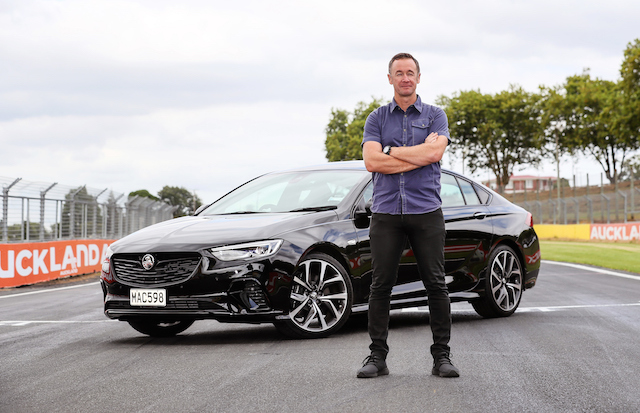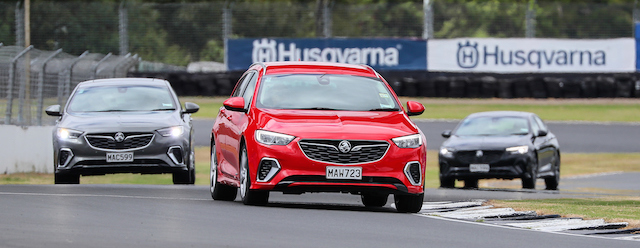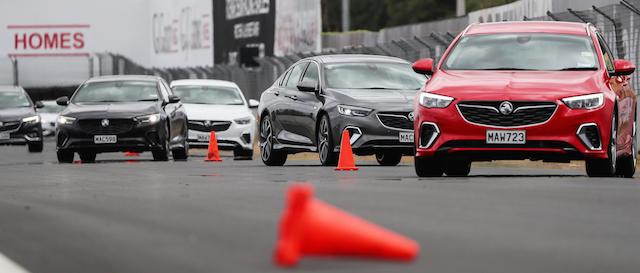
Me and Greg Murphy were talking about nothing in particular at a Holden event late last year. “Driven the two-litre Commodore yet?” he said. I hadn’t. I had had a drive of the all-wheel-drive V6 but not the front-drive 2.0-litre.
“You’ll have difficulty telling whether it’s front or rear drive,” he said. “It shows nothing of traditional front-drive characteristics – it’s so neutral.”
Greg of course was pretty much weaned on rear-drive Holdens. He might be a Holden Ambassador but he will quickly tell you what he does and does not like about anything and everything. Always has.
He was at the Pukekohe track the other day at a special event to mark the first anniversary in New Zealand of the ZB Commodore, the liftback/wagon range built in Germany by Opel and rebadged Holden.
Among the lineup of eight ZB models available to drive was a 2.0-litre four-cylinder, a Calais-spec liftback. Me and former Autocar NZ editor Paul Owen shared it. Rather, he did the driving, I was co-pilot. We’d already driven a handful of V6 models, one of them with me at the wheel and Greg in the back seat.
Greg’s presence took me back down memory lane, to when we both had a bit to do with passionate driver safety instructor Wayne Price, who died of a heart attack in October, 2007, (* The obituary I wrote for the NZ Herald is reprinted at the bottom of this page, if only because people continue to die in alarming numbers on NZ roads).
Another time Greg was teaching me how to best use anti-lock braking technology. It was at Pukekohe. This was years ago, long before Hampton Downs was anywhere near a drawing board.
We were in a lefty Porsche 911, at the end of a day of Porsches. I accelerated hard out of the right-hander into the back straight and towards a handful of cones. The idea was to steer around the cones under brakes, in the process making full use of the anti-lock system.
I jumped hard on the brakes, steering the Porsche left then right around the cones. That’s when the car filled with smoke. “What the hell?” The heavy braking had locked up and flat-spotted the lefty’s nearside rear tyre.
“Move over,” said Greg, “I’ve never driven a flat-spot at speed – I want to feel what’s it’s like.” We later learned that technicians figured it was the end of the day’s play and had recalibrated the lefty Porsche’s brakes from track to normal settings, hence the lock-up.
There was no evidence of lock-ups at the ZB Commodore event. The track session worked like this: We swapped cars after three laps. I’d drive one car for three laps, Paul would drive another for three laps. By the time it came to the 2.0-litre model, it was Paul’s turn behind the wheel.
He had driven the 2.0-litre on an economy run but never on the track. Mid-way into his first lap he brought up a conversation he had with Peter Louisson, deputy editor of Autocar NZ. “Pete reckons this is the pick of the Commodore range.” Both men are hardcore motoring enthusiasts, recognised as particularly good judges of things on wheels, both two and four.
Paul didn’t say too much for the next few minutes. The old competitive spirit had kicked in as he worked racing lines. He chuckled a lot. As a young fella he raced motorbikes around Pukekohe. Since then he’s driven damn near everything, including stuff that was made before he was born in the mid-1950s.
Coming out of the right-hander and into the back straight on his last lap in the Commodore, he said: “I know which one I’d buy.” Later, in pit lane: “I got 3.8 litres on that economy run last year.” That’s 3.8 litres of petrol for 100km. That’s 75mpg.
Therein lies part of the 2.0-litre car’s appeal, that and the 191kW/350Nm the engine delivers. The rest of it deals mostly with the excellent ride and accurate handling the overall ZB Commodore range offers.
Australian Rob Trubiani (above) likes them all. He has to – he’s the lead engineer on the Commodore ZB project. Word is he has special clearance to every engineering facility in the General Motors empire. That’s his business.
The first time he drove the 2-litre was in Germany, when it was badged the Opel Insignia. “I had just arrived at Opel and one of the guys there said we would heading to the proving ground to drive the 2-litre model,” Trubiani said. “Oh, okay, I thought. Then before I knew it we were doing 240km/h.”
Obituary: Wayne Price.
NZ Herald, October 26, 2007: Sometime last Tuesday, God learned how to do a proper three-point turn, swing and not lift His foot from the accelerator to the brake pedal, put His hands on the steering wheel in the 9-3 o’clock position, and look way beyond the car in front.
Welshman Wayne Price had arrived in Heaven from Auckland. Odds-on, he would have told God: “There’s carnage on the road down there, mate. You’ve gotta pass on some driving skills. Get the message across. Here, let me show you how it’s done.”
Price ran what is New Zealand’s most comprehensive driver training centre, on land leased from the Ardmore Airport Authority. Some would call him passionate. Others, those whose egos he had bruised, would say he was obsessive.
The former British Army driving instructor came to New Zealand in 1994 to work with the Automobile Association. What he saw scared him.
“I saw a need for higher driving skills because I was shocked at the carnage and the unwillingness of the Government to save on the social costs of accidents,” he said.
He wrote letters to local and national politicians urging them to back state-owned driving centres. “But while they all agreed that driving skills are important, they didn’t see a need for government to get involved in the driver-education business,” he said.
So Price went it alone. He left the AA and set up his own driving school from his home in Howick. He showed big fleet companies how to reduce accident rates and costs. Hire car company Avis liked what he did. So did racing driver Greg Murphy and radio host Leighton Smith.
A few years ago, he found land near Ardmore airport. Price mapped out plans to use an old runway as a “highway.” Papakura District Council okayed the project.
Not long after the driving centre was up and running, the California Highway Patrol recommended a new way to hold the steering wheel: 8 to 4 on a clockface, not 10 to 2 or 9 to 3.
The reason? Airbags mostly. During a collision an airbag will explode out at more than 160 km/h, protecting the driver’s head and chest against hitting the steering wheel. But with the hands at 10-2 or higher on the wheel, said researchers at CHiPs, the airbag can throw a driver’s arms back into his or her face as it deploys.
Price went with 9-3. ” I prefer 9-3 because the hands are better balanced. It gives you better control. If you shuffle the wheel around bends you have to shuffle it back to the straight-ahead again. You never have the car fully under control.”
That was what Price taught: control of the car at all times. Korean carmaker Kia sponsored the centre and Price had instructors to help with tuition. A couple of them found him on the centre’s “highway” on Tuesday morning. He was lying near cones he had been putting out for the day’s instruction. Heart attack, they reckon.




